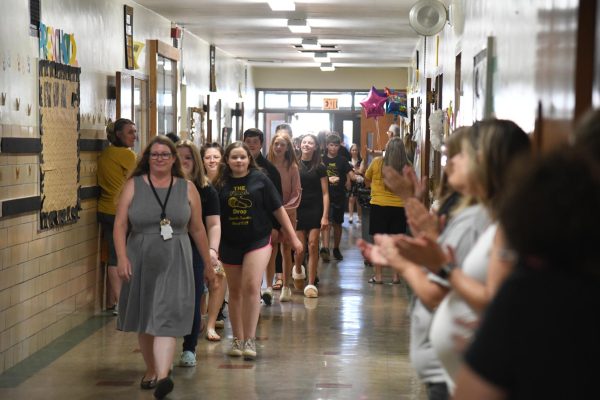As students at River View, the largest school district in Coshocton County, return to their classrooms Tuesday morning, they will be arriving at buildings and a school system that underwent many changes from when they left just a few short months ago.
The closure of both the Keene and Conesville Elementary buildings, which will place all lower-grade elementary students into a single building together, at River View Elementary – formally known as Warsaw Elementary, was deemed necessary by district leaders to increase economic efficiencies as well as to address a declining student population, a trend that has been occurring locally, and statewide for many years.
From the closure of the WestRock Paper Mill in 2015, which took hundreds of jobs from the community, to the recent shutdown of the coal-fired electric generation station, the Conesville Power Plant, which was located inside the River View School District, both took away crucial funding from the school system’s budget, both indirectly and directly. Each along with an aging as well as dwindling population, forced difficult decisions to be made in the best interest of attending students, which ultimately culminated with the closure of three aging buildings over the past few years.
Renovations and a shuffling of students will now have those in both the seventh and eighth grades joining their peers at the high school and the former junior high, now called River View Intermediate, housing students grades three through six.
Meanwhile, state leaders have been working on a plan to provide funding to districts like River View to eventually construct new buildings, placing them alongside their peers around the region and state that have a portfolio of much newer buildings.
Back in May, on the last day of school for River View, we got exclusive and unfettered access to interview, document and photograph what would be the very last time both the Keene and Conesville Elementary buildings would house students in the rural district north of Muskingum County.
Like many districts across rural southeast Ohio, River View has faced both economic and population headwinds slowly chipping away at what was once a thriving community and population. As Ohio lost its manufacturing, as national leaders and businesses shipped jobs overseas and eliminated tariffs, which protected American industry, especially after the conclusion of the first Cold War, Ohio became what is commonly referred to as the Rust Belt, areas that experienced industrial decline.
The WestRock Paper Mill, for example, made a sizable profit per month, reportedly in the millions, but as private equity sought even higher returns and the country’s economy shifted, by the time of its closure in 2015, right before Christmas, nearly 200 jobs were taken from the community.
Likewise, as regulations increased around the burning of coal, as well as the dramatical lowering of natural gas prices and renewables, such as solar, the coal-fired Conesville Power Plant, which first opened in 1957 was gradually taken offline, until its complete shutdown in April 2020.
The loss of jobs and economic infusion into the community was devastating. When coupled with an already decreasing student population, such as families having fewer children than the previous generations, but also as young people left after graduation and never returned, as middle-class jobs became more scarce in the community, employment that once offered plenty of opportunity and economic mobility, as was the case across Appalachia, no longer did.
A generation of Baby Boomers needing an education, which in many communities like Coshocton County observed the highest rates of student attendance ever, required additional buildings. The consolidation of much smaller districts into more economically run ones with more students over a larger geographic area and a curriculum to rival that of the Soviet Union, who attempted to out-educate us in their quest to overtake America’s position as the world’s top superpower, following the conclusion of Second World War, required buildings and additions that are no longer needed and often unfit for learning.
Many new high schools were built during that time of rapid consolidation. Ohio went from having 2,674 school districts in 1915 to far fewer during the 50s and 60s when most consolidation occurred. Today Ohio has only 611 school districts statewide, three of which are majority located in Coshocton County, River View, Coshocton and Ridgewood.
In 1962, for example, River View was created from the merger of the Three Rivers Local, Union Local and Warsaw Local School Districts. Ground for the new high school, located along State Route 60 and still presently used, was broken in June of 1964.
According to data collected by us, in the 1977-1978 school year River View had 2,976 students in attendance. During the 2022-2023 school year, the district only had 1,617 students, a loss of 45.7 percent over the 45 years, roughly one percent loss a year.
During the 1992-1993 school year River View had seven buildings in its district, Rainbow Elementary (preschool only), Conesville Elementary (K-6), Keene Elementary (K-6), Union Elementary (K-6), Warsaw Elementary (K-6), River View Middle (7-8) and River View High (9-12).
Rainbow, which was located at the intersection of Otsego Avenue and Cassingham Hollow Drive, and has since been demolished, just south of the City of Coshocton, was the most recent to be closed until Union was at the end of the 2018-2019 school year when financial difficulties for the district started to become more pressing. Some of the most recent attempts at a levy, which voters struck down in November 2019 and March 2020, would have placed an income tax on residents to help mitigate the roughly $2 million per year lost with the closure of the Conesville Power Plant.

Jarred Renner was the final principal at Union Elementary when it closed a few years back and was, until the last day of school in May, the principal at Conesville Elementary, he will now be the principal at River View Intermediate.
“It hasn’t really sunk in yet,” Renner said in May about once again being the last one to oversee students at another shuttered building in the district. “We’ve been working on so many preparations for the move and end-of-year activities – we want to make sure we make those end-of-year activities special for the kids, for our staff, for our community, so we’ve had some open houses, we’ve had some public gatherings, we’re going to end that with our last Conesville Alumni Banquet. We want to go through and make this special the right way, but it hasn’t really sunk in being the last of everything, we keep saying ‘this is the last this’ or ‘this is the last that’ but I don’t think it’s really sunk in, I think tomorrow (the first day of summer break) when we are here as a staff and there are no students and we start packing boxes that’s when it’s really going to hit home for everyone that yes it is over.”
Renner went to school at Keene Elementary, the other elementary which closed, having originally opened in 1914, and which was against best efforts showing its age. Conesville Elementary, which was the district’s southernmost building, was opened in 1916. Those buildings once hosted students of all grade levels and each had walls dedicated to the photos of the few high school graduates each year before consolidation turned them into only elementary buildings.
Union was a smaller building for Renner, holding roughly 150 kids, though when he took over Conesville, which typically housed between 330 to 340 students, he recalled the excitement of the first day which within an hour of the arrival of students showcased the age of the structure he and his students were in as they had sewage backing up in the building.
“So on my very first day of school here it was like ‘welcome to Conesville – first emergency happens on the first day of school’ and so we worked through that. Over the years being in an older building you have things like that come up, like the electricity goes out, the sewage backs up, something doesn’t work and the heat goes out, so working through those things, being an older building it adds a little bit that those with newer buildings, they don’t deal with that, but it’s one of those things that over the years, it’s one of the things we’ve joked about ‘oh the sewage is backing up again’ or something like that,” Renner said smiling as he recalled it as one of the stories of his time at the building.
As one of the many students and faculty we interviewed, hopefully which will act as a historic record for the community, one in which videos will be watched decades into the future, we spoke to Addisyn Henry (pronounced as Addison), a then 4th grader at Conesville, who attended the building since preschool and recalled the many great memories and experiences she and her fellow classmates had like so many before them, at the building which has educated numerous generations. She spoke of the friendships that made the time go quicker and the teachers who made learning seem effortless and fun, but she also had a message about the building itself.
“When I heard that the school was going to close I was very sad because of all the memories, because there’s pictures, all the places that you’ve stepped, the first kids that ran the school – there were things from them in there so it’s going to be very hard to leave,” said Henry. “I hope whoever buys it, don’t tear it down, please.”
The building is now empty, though it doesn’t appear an official decision has been made, Henry is right, someone will likely buy it, as was the case with Union. Its fate beyond that, as Henry said, will be up to the purchaser. The building sits across from a church and on the outskirts of the Village of Conesville. Many towns have turned their buildings into community centers, typically, that is the most common, according to our data, when a building is sold versus when new buildings are constructed and the state provides funding to demolish the old structures.
At Keene Elementary, Principal Jerry Olinger, like many employees in the school system, have a personal connection to the district and its buildings. Olinger started his education in first grade at Keene during the 1964-1965 school year, he would return as it’s principal in 2001 and serve for many years until 2013 when he became the principal at the River View Junior High, where he retired. Due to a retirement at Keene, he was asked, and agreed, to come back to be the final principal ever at the building which has stood for over a century.
“Today is the last day, ya,” Olinger began his interview smiling. “I don’t know, it’s just awesome, I started here, I’m closing here, so in other words in 37 years I guess I didn’t get real far but I went a lot of places in that time.”
“It’s been a great district to work for, we really like serving people in this building, that’s what it’s all about. A matter of fact, in this very room right here is where I was in first grade, really, so its kind of neat, ya.”
Keene, according to state data, only had 126 students this past year, one classroom for each grade, kindergarten through sixth, Conesville had two classrooms per grade. The State of Ohio, which helps fund a sizable portion of new buildings, in comparison, won’t allow a structure to be built with a designed capacity of less than 300 students. Its walls too feature photographs of graduating seniors who called Keene home for all of their school years, many of whom stayed in the community and became employees and respectable members of society.
Like at Conesville, the students and faculty spoke highly of their time at the building. As Keene was the building we visited in the afternoon of the last day of school, as opposed to our visit that morning to Conesville, the reality of the final hours brought with it a realization that the hourglass of time that Keene has enjoyed, more than many buildings ever get to have, was on its last drops, many tears were had as that reality set in.
Madilyn Angle, a 4th grader at Keene, who like many of her peers had been at the building since their education began, said she loved the school and she wasn’t ready to leave.
“We played Easter Bunny with the kindergarten,” Angle said smiling as she recalled that and many other games the students enjoyed together. Unlike much larger buildings where students only often spend time with their peers in the same grade level, the small building created a bond across the ages, that research is now showing to be quite beneficial to the growth of students, and as seen by our interviews, created a bond not often seen at larger elementary buildings around the state that can easily hold a thousand elementary students.
“I made a lot of memories here. I’ve been here for five years and I made a lot of friends, the school has meant a lot to me and I don’t want to leave because of that,” added Angle.
Nicole Raber, a kindergarten teacher at Keene, who had spent the last five years at the building said what so many others also did, River View and each building were like a family, in the small buildings bonds and experiences were more closely tied together.
“Everyone here is just so friendly and we all take care of each other, pray for each other, we love our kids, we’re really involved with families and it’s just awesome,” said Raber.
At a small building like Keene, teachers, just like their students, got to know everyone, every face was familiar, and each connection was personal. For Raber, nearly every student at the building had her as their kindergarten teacher, she got to watch her students become first graders then second graders and so on and so forth, each student was not just her kid in the sense of a close family at the building but was also, at one point in the past five years, one of her former students.
“I’ve taught all of them as they’ve gone up through, so it’s nice to watch them grow and it’s kind of like, I have kids also, but it’s like when you’re a parent and it happens so quick and it’s joyful but its also sad to watch them grow up and go on, but ya it’s awesome,” Raber added.
Near the end of the day students, led by their principal and teachers, got to walk one final time through the building, performing a funny dance, with huge smiles on their faces, as they were soon to become the last River View students to ever hear the final bell ring at Keene Elementary.
As they departed for their houses by foot, their parent’s cars outside or the buses outback, their legacy was left not just in the memories they had at the building but in their names, written hours earlier on the walls, forever placing themselves as the last of those in a very long line of students to receive an education at Keene. The memories of their parents, grandparents, and even in some cases great-grandparents, along with theirs, will become part of the oral memory they will someday pass down to their kids and grandkids. Long after the physical building is gone, those memories, those friendships, and the joy that building fostered will hopefully live on far longer.
A special thanks to everyone at River View for allowing us exclusive access to cover the last day of school for these two buildings. An archive of photos and videos will be made available on social media as well as placed into our internal archives, ideally to be viewed decades, and maybe even centuries, into the future.




